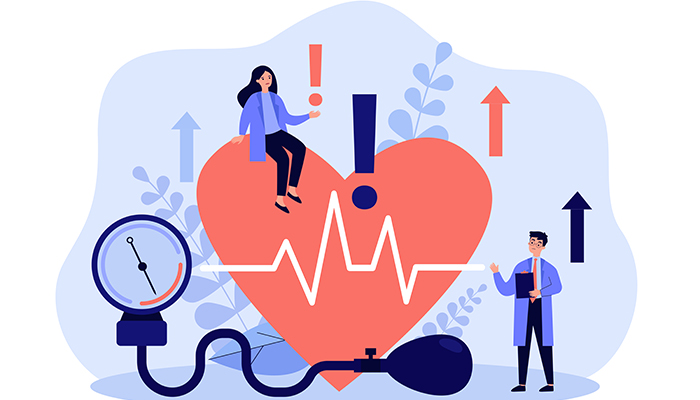Everyday changes Dr Garcia suggests for better cardiovascular health
Everyday changes Dr Garcia suggests for better cardiovascular health
Blog Article
Comprehending the Relevance of Cardiology in Modern Health Care Providers
Cardiology plays an important role in modern medical care, specifically as cardiovascular disease proceeds to be the leading source of death worldwide. Breakthroughs in diagnostics and treatment have changed client care, enabling earlier treatments and improved results. Furthermore, the change in the direction of preventive cardiology encourages people to manage their wellness proactively. As modern technology continues to evolve, the combination of innovative options may additionally redefine cardiology's influence on public health and wellness, triggering a more detailed examination of emerging patterns and their ramifications.
The Frequency of Heart Illness and Its Impact on Public Wellness
Although heart problem remains the leading cause of death worldwide, its effect prolongs far beyond private people to affect public wellness systems and economies. The high frequency of heart problem places a substantial stress on health care resources, demanding increased financing for recovery, therapy, and avoidance programs. Public wellness initiatives should attend to risk aspects such as excessive weight, smoking, and less active way of livings, which add substantially to the climbing incidence of heart conditions.Moreover, the financial problem connected with heart disease is immense, incorporating not only straight clinical expenses yet additionally indirect costs associated with shed efficiency and premature mortality. Areas encounter difficulties in taking care of these prices, typically resulting in variations in healthcare accessibility and results. As the populace ages and lifestyle-related risks remain to escalate, the urgency for effective cardiology interventions comes to be paramount. Addressing heart illness is not just an issue of specific health but additionally a vital public health and wellness top priority.
Breakthroughs in Heart Diagnostics and Imaging Techniques
Current developments in cardiac diagnostics and imaging methods have actually changed the area of cardiology, improving the ability to spot and check cardiovascular disease. Methods such as heart MRI, CT angiography, and echocardiography have actually come to be increasingly innovative, providing thorough photos of cardiac frameworks and functions. These modalities permit the early recognition of conditions like coronary artery illness, cardiac arrest, and valvular disorders.Moreover, advancements in non-invasive diagnostics, such as wearable modern technology and remote surveillance tools, have actually encouraged people and doctor. These devices facilitate real-time monitoring of heart rhythms and various other necessary signs, resulting in prompt interventions. In addition, synthetic knowledge is being incorporated right into imaging evaluation, improving precision and efficiency in medical diagnosis.
Innovations in Therapy Choices for Heart Conditions
Current advancements in cardiology have actually resulted in significant innovations in treatment choices for heart disease. These include innovative surgical methods that enhance step-by-step outcomes and emerging medicines that use new opportunities for treatment. As the area progresses, these developments play a vital function in enhancing individual care and results.
Advanced Surgical Techniques
Technologies in medical methods have changed the landscape of cardiology, supplying brand-new wish for clients with heart disease. Minimally invasive treatments, such as catheter-based treatments, have greatly decreased healing times and healthcare facility remains. Methods like robotic-assisted surgical treatment boost accuracy, enabling doctors to navigate intricate anatomical structures with greater accuracy. Innovations in imaging modern technology promote real-time visualization throughout treatments, boosting results. Transcatheter aortic valve replacement (TAVR) exemplifies an advancement in dealing with aortic constriction, enabling valve substitute without open-heart surgical treatment. Furthermore, hybrid methods that incorporate medical and catheter-based approaches offer customized remedies for different heart issues. These innovative surgical methods not just improve patient safety however additionally increase treatment choices, emphasizing the crucial function of technology in modern cardiology methods.
Emerging Therapies and drugs
As the landscape of cardiology proceeds to develop, arising treatments and medicines play a pivotal duty in improving therapy choices for heart disease. Technologies such as novel anticoagulants and advanced lipid-lowering representatives have actually transformed the management of cardiovascular conditions, greatly decreasing patient morbidity and death. In addition, the development of gene treatments and regenerative medication supplies appealing methods for dealing with conditions previously regarded permanent. Clinical tests are continually exposing the efficacy of these therapies, pressing the boundaries of standard treatments. The assimilation of digital health innovations promotes personalized medicine, enabling for customized therapy plans based on genetic and way of life aspects. Jointly, these advancements highlight the vibrant nature of cardiology, enhancing person outcomes and redefining standards of care in contemporary health care.
The Function of Preventive Cardiology in Person Treatment
Preventative cardiology plays an important duty in individual treatment by concentrating on the recognition of threat variables that add to cardiovascular disease. Through lifestyle modification strategies and early detection techniques, healthcare service providers can efficiently minimize the incidence of cardiovascular events - Cardiology care. This positive method not only improves patient outcomes yet additionally advertises long-lasting health
Risk Factor Recognition
While heart diseases remain a leading source of morbidity and death worldwide, efficient danger element identification offers as a foundation of precautionary cardiology. Identifying threat aspects such as hypertension, hyperlipidemia, family members, and diabetic issues background is vital for early treatment. Healthcare specialists use various evaluating methods to review these elements, enabling tailored preventative steps. In addition, comprehending a patient's way of living options, such as smoking and physical lack of exercise, further notifies risk evaluations. This comprehensive analysis enables medical professionals to develop individualized care plans targeted at mitigating risks. By prioritizing threat factor recognition, medical care systems can enhance individual end results and decrease the total burden of cardiovascular illness, inevitably adding to enhanced public wellness strategies and source allocation.
Lifestyle Adjustment Approaches
A multitude of research studies highlights the essential role of lifestyle adjustment methods in lowering cardiovascular disease risk. These techniques include nutritional adjustments, raised physical activity, smoking cessation, and weight administration. view website By embracing a heart-healthy diet plan abundant in fruits, veggies, entire grains, and lean healthy proteins, people can reduce cholesterol degrees and blood stress. Normal exercise strengthens the heart and improves overall cardio wellness. In addition, giving up smoking cigarettes greatly reduces the risk of heart problem and boosts recuperation prices for those with current conditions. Weight administration even more contributes to cardiovascular wellness by minimizing various other danger elements such as diabetic issues and hypertension. Implementing these way of living transforms not just promotes individual health yet likewise acts as a cornerstone of preventative cardiology in individual care.
Early Discovery Methods
Lifestyle alterations substantially add to reducing heart disease risks, yet they are most efficient when coupled with very early discovery techniques. Preventative cardiology highlights the significance of recognizing prospective heart concerns before they escalate right into serious problems. Techniques such as blood stress tracking, cholesterol testing, and advanced imaging modern technologies like echocardiograms play vital roles in examining cardio wellness. Biomarkers and hereditary testing additionally enhance the accuracy of early discovery, enabling customized preventive methods. Regular cardiac threat assessments encourage doctor to step in proactively, possibly avoiding cardiac arrest and strokes (Cardiology care). By incorporating these early detection approaches right into routine treatment, people can gain from timely way of living treatments and targeted treatments, eventually boosting outcomes and enhancing quality of life
Integrating Innovation Into Cardiology Practices
As innovations in technology remain to reshape different areas, the assimilation of innovative tools and systems into cardiology methods has actually come to be essential for enhancing client care and results. Telemedicine systems allow cardiologists to check people from another location, improving access to care while reducing the concern on healthcare centers. Wearable tools, such as smartwatches, make it possible for continual heart price surveillance, signaling both patients and physicians to potential concerns in real-time. In addition, fabricated knowledge (AI) is being used to examine huge amounts of cardiac data, aiding in very early medical diagnosis and individualized treatment plans. Advanced imaging techniques, consisting of 3D echocardiography, boost visualization of heart structures, resulting in much more precise treatments. Digital health and wellness records (EHRs) streamline person details administration, guaranteeing that cardiologists have immediate accessibility additional info to vital data. Together, these technical developments are transforming cardiology, advertising positive management and boosted health and wellness outcomes for people with cardiovascular conditions.
The Relevance of Individual Education And Learning and Interaction
Patient education and involvement play a critical duty in the management of cardio health. By furnishing patients with understanding concerning their conditions, treatment alternatives, and lifestyle modifications, doctor empower people to take an energetic role in their treatment. This aggressive method can cause boosted adherence to prescribed medicines, nutritional adjustments, and exercise programs, eventually lowering the risk of complications.Engagement likewise promotes a solid patient-provider partnership, encouraging open communication and count on. When individuals really feel educated and involved, they are more probable to voice worries and ask inquiries, which can bring about better medical results. Furthermore, academic sources, such as workshops or electronic systems, can improve understanding and advertise self-management methods. On the whole, focusing on person education and learning and involvement is essential for enhancing cardiovascular health, improving quality of life, and reducing healthcare prices linked with heart diseases.
Future Fads in Cardiology and Their Prospective Effect

Frequently Asked Questions
What Way Of Living Modifications Can Reduce Heart Condition Danger?
The current inquiry addresses way of life adjustments that can greatly decrease heart problem risk. Dr Garcia. Adopting a well balanced diet regimen, participating in regular exercise, keeping a healthy weight, managing anxiety, and avoiding cigarette can significantly enhance cardiovascular health
Just How Can I Recognize Very Early Indications of Heart Troubles?
Acknowledging very early indications of heart problems includes monitoring signs such as chest discomfort, lack of breath, tiredness, and uneven heartbeat. Prompt awareness of these indications can prompt needed medical examination and treatment for better end results.
What Are the Differences Between Cardiologists and Heart Surgeons?
The differences between cardiologists and heart surgeons exist in their duties; cardiologists mainly handle and identify heart problems through non-invasive techniques, while heart surgeons do surgeries to fix architectural heart concerns. Each plays a vital, unique function.

How Often Should I Obtain My Heart Health And Wellness Checked?
The frequency of heart checkup differs based on specific threat variables. Usually, grownups should undertake evaluations each to two years, while those with status quo might need even more regular assessments as suggested by health care professionals.
What Duty Does Genetics Play in Heart Condition Danger?
Genetics considerably influences cardiovascular disease risk, with familial patterns showing inherited problems. Particular genetics can predispose people to high blood pressure, cholesterol concerns, and various other cardio problems, highlighting the importance of hereditary screening in reviewing heart health. Heart disease remains the leading reason of fatality internationally, its impact expands much beyond private people to influence public wellness systems and economic situations. Public health campaigns should address danger variables such as obesity, cigarette smoking, and sedentary way of livings, which add greatly to the increasing incidence of heart conditions.Moreover, the financial worry associated with heart condition is immense, encompassing not only straight clinical prices yet likewise indirect expenditures associated to lost performance and premature death. Preventative cardiology plays an important duty in person care by focusing on the identification of danger aspects that add to heart condition. Artificial intelligence (AI) and device knowing are improving diagnostics and individual surveillance, making it possible for very early discovery of heart diseases. The differences between cardiologists and cardiac surgeons lie in their roles; cardiologists primarily diagnose and manage heart this contact form conditions through non-invasive methods, while heart doctors execute medical treatments to remedy structural heart issues.
Report this page